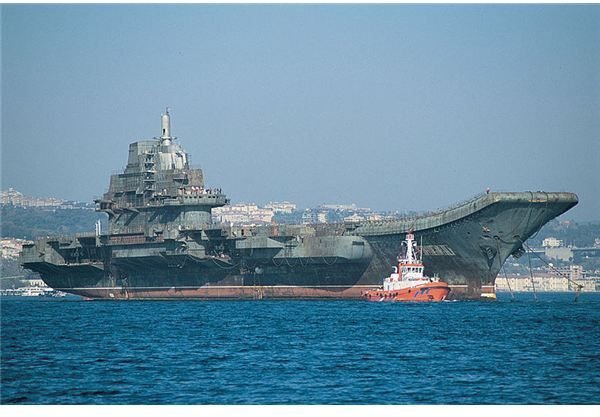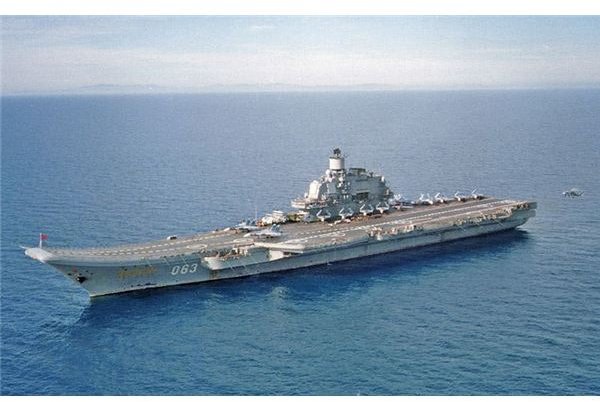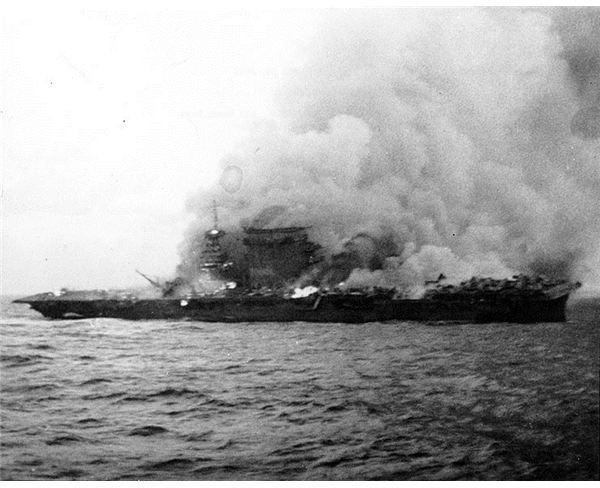The New Chinese Aircraft Carrier Shi Lang is Not a Threat
As of mid-2011 it is official: China has built an operational aircraft carrier!
With the revamp of the incomplete Soviet carrier Varyag, China has assumed the mantle of great power status at sea. And China isn’t stopping here- numerous reports indicate that more carriers are on the way.
Now comes the debate: is the new Chinese aircraft carrier a threat? To put it bluntly, I don’t think it is, but not for the same reasons offered by most commentators.
Summon the Chattering Class: China Has an Aircraft Carrier
The race is on, but no, not to counter the new capabilities this vessel, reportedly named the Shi Lang, may offer the People’s Liberation Army Navy (PLAN). Rather the race is on to see how fast the military pundit class can come to a consensus about what such a development means.
It appears that most writers who have an opinion to offer on the matter fall into one of two camps. Either they’re defense industry/Pentagon types who argue the Chinese carrier represents a significant step forward (budget justifications, anyone?), or they are analysts (usually of the armchair variety) who insist that Chinese possession of carrier technology is ultimately meaningless. Some of the latter hold that Shi Lang is a Soviet relic and inherently useless, others insist that US Naval strength is so overwhelming that all the world’s carriers put together pose no threat.
Of course, virtually everyone willing to share their opinion is a journalist or pundit from a Western nation, particularly the United States. To date, no Chinese admiral or politician has stepped forward to reveal Shi Lang’s mission or even her characteristics except to state that she is to be a training platform and model for later development. But just looking at the facts it seems clear that one hypothesis ought to rise above the oversimplifications proffered by most commentators: that Shi Lang represents a physical as well as symbolic step forward, but not one that poses a threat to US interests in Asia or elsewhere.
Technological Disparities do not Demonstrate Why Shi Lang is Not a Threat
I respectfully disagree with writers who assert that US Naval dominance is so strong that a single Chinese carrier is effectively useless. It is true that the US has eleven carriers on active duty, some others in reserve, and is even building a new type- the Gerald Ford class- to replace older hulls. And it is also true that each US carrier is larger and can carry more aircraft than this new Chinese aircraft carrier. But side by side statistical comparisons only tell part of the story.
During the
Second World War, Japanese aircraft carriers often carried fewer aircraft and were less well defended than their American counterparts. This did not stop the carriers Shokaku and Zuikaku from sinking the USS Lexington and crippling the USS Yorktown in the Battle of the Coral Sea even though the two sides had approximately the same number of aircraft to throw at one another. Battles do not always resolve in favor of the side with the most or the best guns. Skill and luck always play a vital role. It is therefore dangerous to simply assume that Shi Lang poses no technical threat to a US carrier battle group operating near China. Aircraft carrier battle groups can fall prey to the ravages of luck and Clausewitz’s “friction” the same way Japan’s carrier force ran headlong into them at Midway.
Analysis of the threat Shi Lang does or does not pose simply cannot be judged by looking at technical characteristics. However, this is not a sop to the Pentagon side of the argument - even though a Chinese carrier poses a technical threat to US naval vessels, the very nature of the geographic location of China means that no Chinese carrier force will ever be even as much of a threat to US interests as the Soviet Union’s carrier fleet once was. Budgets do not need to go up, folks.
What Chinese Carriers are For
China is not made to be a naval power. Historically and militarily China has, in the past, built and maintained large fleets. But historically and militarily China has always faced its greatest threats on land and has even completely disbanded the entirety of its naval forces at times. From the Mongol invasions to the divide and conquer colonial strategies employed by the European powers in the nineteenth century, China’s survival as a cohesive nation has always depended more on its control of land than sea. It is and will likely remain a continental power.
Unlike the United States or even Great Britain, China’s coastline is never more than a few hundred miles distant from land bases controlled by potentially hostile powers. Taiwan, Japan, Korea - all are US allies and host US military assets. Okinawa is a major Marine base and is closer to Beijing than much of China. Southeast Asia has always had one or more nations willing to play host to US bases. Effectively China’s ports and naval bases are surrounded. It can be effectively cut off from its access to the greater Pacific by the simple activation of a few anti-ship missile sites. Even if China eventually deploys six aircraft carriers as it apparently intends the PLAN would still have an exceptionally difficult time posing a true threat to the United States.

Shi Lang is not a rusty relic with a new paint job. She’s been in the yard for over eight years and is guaranteed to be almost entirely revamped and modernized. And she would certainly pose a threat in a shooting war to a US carrier she took on head to head. I strongly suspect that the majority of Admirals and Captains in the US Navy would agree that if they were in a shooting war situation and knew Shi Lang was within a few hundred miles that they would be deeply concerned and disinclined to write her off as a rust bucket with new paint.
But this does not mean that the deployment of this new Chinese aircraft carrier poses an inherent threat to US interests by China. Aircraft carrier battle groups that don’t have several hundred miles of open ocean around them had better be operating under friendly air cover lest they fall prey to saturation attacks, a lesson the US learned to its cost in operations off Okinawa and Japan in 1945.
The Chinese are not fools. They know this. And this is why Shi Lang’s development is accompanied by the deployment of ballistic missiles that can reportedly strike a carrier at sea, anti-satellite technology, information warfare, and modern strike aircraft. In this context, Shi Lang is just one aspect of a Chinese defense strategy that involves keeping enemy aircraft carriers and other threats far away from its long coast.
Shi Lang represents China’s ability to extend its air defenses a bit further out into the Pacific, nothing more. It will most likely operate within the range of supporting land bases in the East China Sea or South China Sea and support the transit of submarines into the Pacific. It is not an offensive vessel in the same vein as a US carrier: a floating piece of sovereign territory. It is a mobile airbase to be employed in war cautiously and in a limited manner close to home. It is a defensive vessel, not a threat to US interests, not a ship that will try to close Malacca or Hormuz.
In truth, China’s accession to the carrier club is intended to be symbolic- after all, every other member of the Security Council has nukes and carriers, so why not China? But as a symbol, Shi Lang can actually stand for more than mere technological maturity. It could actually be a symbol that is embraced by the United States itself, and mark a new direction in US military policy.
The Opportunity Inherent in Chinese Carriers
Shi Lang- only her presumed name, by the way, as this has never been confirmed by China and would seem to be unduly provocative since the historic Shi Lang was a Chinese admiral who helped conquer Taiwan- could well be embraced by the United States’ budget conscious military establishment not to highlight China’s reputed threat to the US, but to point out its maturity as a partner.
Americans have to face certain facts. One of them is that spending more money than the rest of the world combined on its military is a road to ruin trod by empire after empire in the past. Another is that war with China is far less likely than war with the Soviet Union ever was; the US and China are so economically linked that war would be catastrophic for both. Modern China is also not truly ideological. For all the lip service paid to Communism, China is effectively a capitalist state. China does have an improving military and a wretched human rights record (Tibet, anyone?), but its growing power is an opportunity to be exploited if US officials have the stones necessary to move on it.
That opportunity is one of engagement. US interests are more directly threatened by piracy, insurgent groups, and bloody wars than China’s rise. Shi Lang could actually be used as a vehicle to incorporate China deeper into the international system. Imagine a new Chinese aircraft carrier operating under the auspices of the UN to provide disaster relief. Or helping to control piracy off the Horn of Africa. Imagine a US carrier sailing alongside Shi Lang on a circumnavigation of the globe with port visits on all the continents. Or cultural exchanges between US and Chinese Naval forces. What if the US actually helped China learn to operate Shi Lang by providing seventy years worth of expertise in what can go wrong?
If we look at Chinese aircraft carriers like Shi Lang through a lens of

cooperation and as an opportunity to build trust, not only can Chinese carriers pose no threat to the US, they could actually be a force for stability in an increasingly dangerous world.
All Images courtesy of the United States Navy, accessed via Wiki Commons
